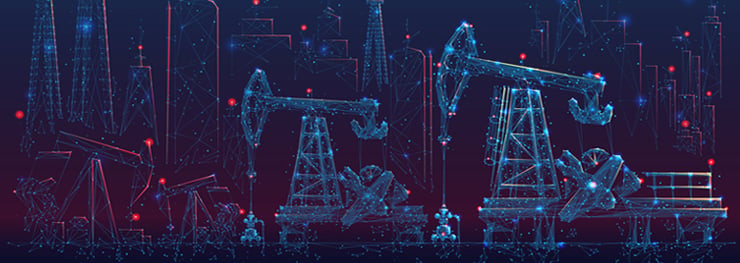
Your Network's Edge®
Blog Post
You are here
Harnessing Real-Time Data and Edge Computing in Oil and Gas Fields
Oil and gas are the primary sources of fuel the world relies on. These two industries play an impactful role in the global economy. However, the production of oil and gas is an expensive and intensive task requiring the latest technology.
As the world moves towards digitization, the oil and gas industry is no exception. Hence, most companies are jumping on the bandwagon. This is because digitization increases revenue. Companies can improve turnaround time on projects and better operational efficiency for the coming years.
In fact, according to Statista, the global base oil industry will experience a total annual growth of 3.67% from 2023 until 2032. The U.S. market alone is expected to reach $18.7B by 2032 and is expected to have the highest Compound Annual Growth Rate of about 4.1% from 2023-2023.
Remote Location
Oil fields are often in remote areas. Typical onshore oil and gas fields can cover an area ranging from hundreds of square feet up to thousands of square feet, while offshore sites can cover large spaces beneath the sea surface and centralized into a few floating stations. The oil and gas site require time and resources to ensure extraction can take place. This includes pumps, compressors, generators, pipelines, wellheads, drilling equipment, and many other devices, often incorporating low-speed telemetry devices and sensors. Edge computing technology is often employed to collect and process data from sensors and devices at various locations to improve security and response times.
The challenge in the oil and gas industry lies in the growing volume of data collected, spanning from real-time updates to longer time intervals, ranging from minutes to hours. The data comes from:
- Sensors in wells
- Drilling systems
- Generators
- Compressors
- Pumps
- Video surveillance
- Remote control
- And automation systems.
Implementing Industrial IoT solutions such as sensor technology can keep costs down as the data is transferred all the time from all remote assets. Therefore, if there is any spill, the technology can determine immediately, and there is less damage.
How the IoT Sensors Work
When large oil and gas companies face equipment breaking down, the system fails, and no oil is produced. This causes a huge loss of income for the industry as a whole.
According to research by the IEA-International Energy Agency, 15% of global energy-related Greenhouse emissions derive from oil and gas extraction. Therefore, reducing methane leaks that disperse into the atmosphere is the most beneficial and cost-effective way to reduce emissions. By having sensors and monitoring devices, alerts can be sent for leakages, pressure, heating levels, and other parameters before they become hazardous.
IoT sensors are critical for data collection and monitoring devices. They are small, rugged, with long battery life, connected and controlled. They are placed on the remote infrastructure and collect data such as temperature, pressure, flow rates, and equipment status.
A recent trend is to deploy edge computing capabilities near the source of data collection, such as well sites and remote facilities. These edge computing devices are required to have sufficient processing power and storage capacity to handle data locally and in real-time. This facilitates on-site data analysis and the examination of historical trends, eliminating the sole reliance on central data repositories.
Real-Time Capabilities
Collecting data in real-time is key when decisions are data-based, such as for safety monitoring equipment and control systems. This data comes from SCADA, video, industrial IoT sensors, and many other devices. It can then be analyzed along with trend algorithms. Since processing is done locally at the edge, latency (delay) is minimized because the data doesn't have to travel to a centralized data center for analysis.
A main advantage of processing data locally is that edge devices can prioritize and filter data before transmitting it to central servers or the cloud. By utilizing edge devices, it can reduce the volume of traffic that needs to be sent over networks, saving bandwidth, and reducing costs.
Cybersecurity
Cybersecurity is another critical topic nowadays as increasingly more companies are being hacked. A prime example was the ransomware attack at Colonial Pipeline in May 2021. Unfortunately, the hackers succeeded in infecting some of the pipeline’s digital systems, shutting it down for several days, and leading to severe damage and losses.
Another example was the attack on Aramco in 2012. A malware by the name “Shamoon” stole passwords and wiped data from 35,000 computers throughout the organization, causing Aramco to spend more than a week restoring their services. This had cost the company millions of dollars in damages.
RAD can enhance the existing encryption and firewall capabilities of the SecFlow device by installing cyber-software containers, such as DDoS protection and anomaly detection systems, among others. In addition, Edge computing can enhance cybersecurity by limiting the exposure of critical infrastructure to external networks. Data can be processed and secured at the edge, reducing the risk of cyberattacks.
Final Thoughts
Overall, IIoT and edge computing play a significant role in the oil and gas industry, improving the efficiency, safety, and reliability of operations in remote and challenging environments. They allow for real-time decision-making, reduce data latency, and enhance the industry's ability to monitor and control critical processes effectively.
RAD provides solutions that address all communication needs of Oil and Gas company's Operational WANs (OWANs), with always-on reliability and mission-critical protection. We deliver best-of-breed multi-protocol and secure Industrial IoT Gateways, edge computing for unrivaled functionality flexibility, TDM to Packet migration, and end-to-end network management.
Learn more about RAD’s solution for the oil and gas industry here.

